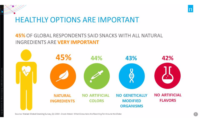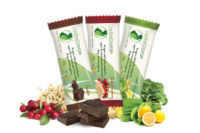‘Better-for-you’ adds up
With consumers demanding healthier treats, manufacturers find natural inclusions deliver goodness and taste.

Protica’s Protein Twist candies are meant to taste like traditional gummy candies, but include a full serving of fruit and 15 grams of protein per cup.







Imagine a day when candy no longer carries an “unhealthy” stigma. That future may not be too far off, particularly if those sweets feature almonds, honey, fruits and even probiotics.
As manufacturers look to create “guilt-free” confections, they’re turning to an expanding assortment of healthy additives to create great tasting products that appeal to both a consumer’s sweet tooth and their doctor.
For example, Protica, Inc., manufactures protein-infused gum, protein gummy candies made with fruit and even protein taffies in the hopes of alluring consumers looking for the indulgence of candy as well as nutritional benefits.
“People are becoming more health-conscious everyday,” says Alex Roth, marketing coordinator for Protica. “Given the option to eat a product that tastes and feels the same as what they are used to, but with healthy ingredients, even the general consumer will try that product.”
Jeff Smith, marketing director for Blue Diamond Almonds’ global ingredients division, sees four reasons for growth in the sector — consumer demand, perceived health benefits, versatility, and price. In other words, the best healthy additive is a multipurpose one.
Several inclusions in particular have shown their versatility this year.
Almonds continue to grow in popularity as a healthy snack. Per capita U.S. consumption has increased by 54% since 2002, and global consumption has grown at a rate of more than 10% per year since 2000.
“Almonds continue to be a ‘favored nut’ in candy — particularly chocolate — and snacks,” says Smith.
The demand for nuts, especially in chocolate, has not gone unnoticed. Major cocoa manufacturer Barry Callebaut’s acquired La Morella Nuts in January in an attempt to respond to increasing customer demand for nuts in their products.
Meanwhile, raisins, often used in snack foods and some confections, remain the top dried fruit, with 41% share of tonnage, according to Mintel research presented by the California Raisin Marketing Board. Raisin usage is also widespread in snacks and confections, with 65 new products having debuted in 2011 incorporating raisins (including snack mixes, snack/cereal/energy bars, fruit snacks, and wrapped chocolate pieces).
Honey, too, also has experienced growth, with use in candies and snacks varying from energy bars to jelly beans.
“Honey’s use in the candy industry is widespread and spans multiple trends,” says Catherine Barry, marketing director for the National Honey Board. “The impressive growth of the jelly bean category has been assisted by honey varieties from brands such as Jelly Belly and Gimbal’s.”
Consumer preference clearly intersects with a growing demand for “pure,” “natural” and “healthy” products — and companies are quick to point out to consumers that their healthy additives provides these benefits.
For example, Protica — which uses a proprietary type of protein called Actinas that helps with absorption and assimilation in the human body — highlights its “all-natural ingredients” on its packaging and marketing materials.
And the National Honey Board pushes its “better-for-you” as uniquely “pure” or “all-natural.”
“How sweeteners are manufactured and their perceived naturalness also has received intense media scrutiny,” says Barry. “Since honey is manufactured in Mother Nature and by bees, manufacturers that sweeten their products with honey don’t have to worry about the perception consumers will have when reading an ingredient listing.”
And, when manufacturers use honey in their products, they often make that clear to the consumer. For example, Brach’s Candy Corn, which has always been made with honey, recently added a note to their packaging highlighting that fact.
Almonds too, are marketed as “a nutritious, clean-label ingredient,” by their advocacy board.
Smith points to research done by the Almond Board of California showing that 75% of consumers believe almonds increase the nutritional value of chocolate. And, almonds recently received the American Heart Association’s signature “Heart Check” mark, which identifies the nuts as a heart-healthy food based on their nutrient profile.
“Many manufacturers are looking to add a health and wellness aspect to their products and almonds fit the bill beautifully,” says Smith. “And while connecting almonds and nutrition seems obvious in certain types of snack products, that halo carries over to confections as well.”
Raisins, however, have not been able to broadcast their nutritional goodness as easily as other inclusions. Because raisins have struggled with misperceptions about their naturalness, the California Raisin Marketing Board decided to launch a new advertising campaign this spring. The campaign will highlight the fact that raisins are sun-dried and not artificially dehydrated.
“Surprisingly…43 out of 46 consumers interviewed believed that raisins were a ‘processed food’ and did not realize they were dried in the sun,” writes Dennis Wilt, chairman of the California Raisin Marketing Board.
Another benefit that some healthy additives can piggyback on involves versatility. Honey, for example, while primarily a sweetener, has a unique taste.
“Honey can be used in multiple ways in confectionery products,” says Barry. “As a sweetener, honey works exceptionally on its own, or paired with other sweeteners to deliver a variety of flavor profiles.”
This flexibility also intersects with honey’s role as a healthy additive — energy and nutritional bar manufacturers can use it as a flavor and as a source of “natural” energy.
“For candy bar or food bar manufacturers looking to capitalize on consumer demands for energy products, honey consumption fills the body with natural energy through its 17 grams of carbohydrates per tablespoon,” says Barry. “This makes the ingredient the ideal sweetener for a line of natural energy bars.”
Functionality also plays a role for manufacturers in determining which healthy additive fits the bill.
As the Almond Board points out, almonds can be used whole, blanched, sliced, slivered, ground, roasted, caramelized, made into almond paste, almond butter or almond milk. The sheer variety of things possible with almonds allows for their use in an array of confectionery products.
Supply, of course, is always a concern for manufacturers, affecting availability and cost. For the 2011-2012 crop, the Almond Board of California projects shipments of more than 839,000 metric tons. Raisins also experienced a strong crop this year, with 66,000 more tons harvested (396,000 vs. 330,000 the year before).
Things look good for natural inclusions — but growth ultimately comes down to what the consumer wants and expects from manufacturers. Candy remains a treat. If a manufacturer loses sight of that, even the healthiest confection will be ignored.
Looking for a reprint of this article?
From high-res PDFs to custom plaques, order your copy today!











